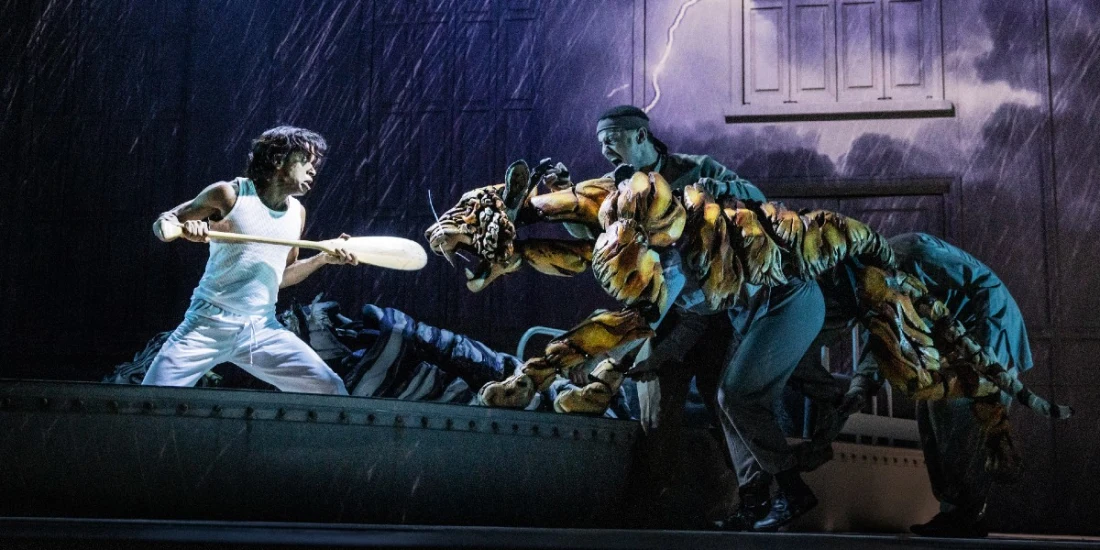'Life of Pi' review — a marvel of theatrical design
Read our four-star review of Life of Pi on Broadway, adapted by Lolita Chakrabarti from Yann Martel's bestselling novel, at the Gerald Schoenfeld Theatre.
How does an Indian teenager adrift in the Pacific Ocean in a tiny lifeboat – with a ferocious Bengal tiger, no less! – live to tell the tale after 227 harrowing days? That question is at the core of Life of Pi, a fantastical fable about survival, faith, and how stories help us make sense of our lives.
Visually, the play is a deeply wondrous spectacle that teems with beauty and brutality. Narratively, the script does less to impress, as if written at times in magic marker, and supporting performances could use some shading. Bottom line for this work on Broadway following runs in London and Cambridge, Massachusetts: The display’s the thing.
Based on Yann Martel’s 2001 novel that spawned an Oscar-winning movie, Lolita Chakrabarti’s stage version begins in 1978 in a hospital room in Mexico. Pi Patel (Hiran Abeysekera, captivating) is questioned by representatives of the Canadian Embassy (Kirstin Louie) and Japanese Ministry of Transport (Daisuke Tsuji). They’re after facts on how the Tsimtsum, a cargo ship bound for Canada, sank eight months earlier – and how Pi defied death. He tells them.
The action moves between the infirmary, Pi’s home, and the middle of the ocean. In 1976 Pondicherry, India, happy-go-lucky Pi’s life in a zoo comes into focus through a series of bite-sized scenes. Butterflies dance in the air, and a giraffe cranes its graceful neck. We meet his zookeeper parents (Rajesh Bose and Mahira Kakkar) and sister (Sonya Venugopal), as well as a zebra, orangutans, a hyena, and a Bengal tiger named Richard Parker, brought to life by puppets and multiple puppeteers.
Each beast is dangerous, a point Pi’s father makes by sacrificing a goat to the tiger. (Note: This is not a kids' show.) The scene shifts to a bustling marketplace, where spiritually inquisitive Pi looks to leaders at a local church, mosque, and temple for answers to his big questions. “If God is good and kind, why is there so much violence in the world?” he asks.
Political unrest compels Pi’s family to leave India with their animals for Canada aboard the Tsimtsum. About 40 minutes into the play, there’s a cry of “Storm coming!” and everything changes. The ship sinks, and from the bare stage, a small lifeboat magically surfaces like a sea creature. Pi climbs into the craft, and he’s not alone. An orangutan, hyena, injured zebra, and Richard Parker have busted out of containers and taken refuge there.
Eventually, only Pi and the tiger remain. To outlast the maneater, he tames the beast and reconciles with its killer instinct – and his own, after going against his beliefs and eating a sea turtle to avoid starvation. When the government investigators in Mexico doubt his tale, Pi spins a parallel yarn – minus animals but with human predators instead.
What’s the takeaway? Maybe it’s as simple as to never give up – and everything that conveys. While lost at sea, Pi talks with the ghost of his sister, who can’t believe he still has faith. “Look at where you are,” she says. “But I’m alive,” Pi responds.
In the end, there’s no question that director Max Webster’s staging is a technical marvel that makes the most of its moving parts. Those include amazing puppetry; evocative scenic, lighting, and sound design; and transporting video and animation effects that conjure the ocean and the sky above.
“My story will make you believe in God,” Pi insists. Whether or not that’s true, it’s impossible to doubt such powerful theatrical stagecraft.
Life of Pi is at the Gerald Schoenfeld Theatre. Get Life of Pi tickets on New York Theatre Guide.
Photo credit: Hiran Abeysekera and Richard Parker (Fred Davis, Scarlet Wilderink, and Andrew Wilson) in Life of Pi on Broadway. (Photos by Matthew Murphy and Evan Zimmerman for MurphyMade)
Originally published on
